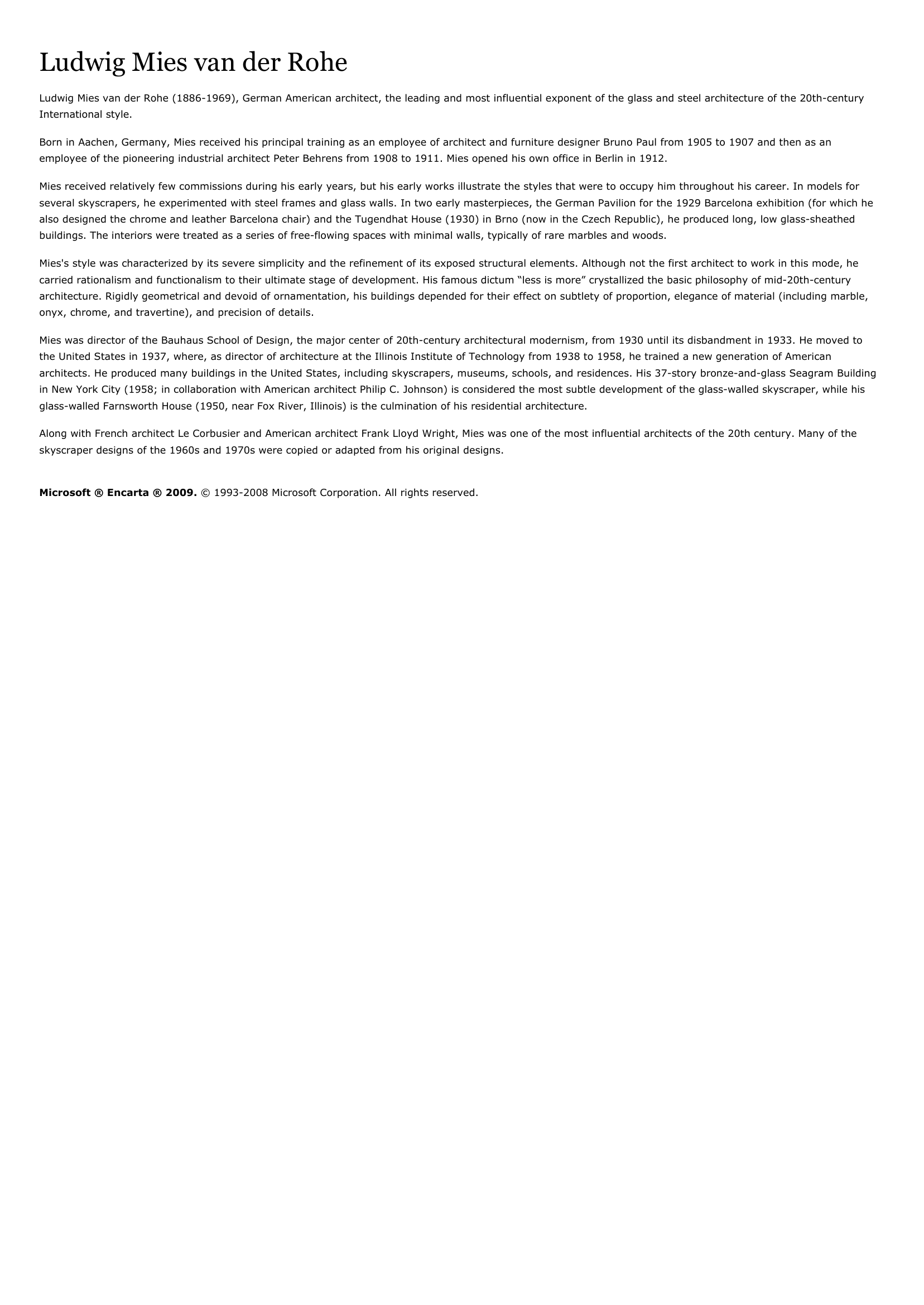Mies van der Rohe Ludwig
Publié le 06/04/2019

Extrait du document
Mies van der Rohe Ludwig Architecte américain d'origine allemande
* 27.3.1886, Aix-la-Chapelle
+ 17.8.1969, Chicago
Avec Walter Gropius, Le Corbusier et Frank Lloyd Wright, il est l'un des plus grands architectes de la première moitié du XXe siècle. Il commence par tester ses ossatures de béton et d'acier sur des stades et des bâtiments d'habitation. Son idéal esthétique implique l'utilisation de matériaux de construction coûteux comme le marbre, le travertin, l'onyx et l'acier chromé. Le pavillon de l'Allemagne à l'exposition internationale de Barcelone en 1929 constitue le premier point culminant de son art. Après avoir dirigé le Bauhaus à Dessau de 1930 à 1933, Mies van der Rohe émigre aux Etats-Unis en 1937, et dirige la faculté d'architecture de l'Illinois Institute of Technology de Chicago de 1938 à 1959. Ses grands immeubles d'habitation (Promontory Apartments de Chicago, 1949, Battery Park Apartments de New York, 1957-58) et le Seagram Building (New York, 1958) exerceront une influence décisive sur l'urbanisme et l'architectonique.
«
Powered by TCPDF (www.tcpdf.org)Ludwig Mies van der Rohe
Ludwig Mies van der Rohe (1886-1969), German American architect, the leading and most influential exponent of the glass and steel architecture of the 20th-century International style.
Born in Aachen, Germany, Mies received his principal training as an employee of architect and furniture designer Bruno Paul from 1905 to 1907 and then as anemployee of the pioneering industrial architect Peter Behrens from 1908 to 1911.
Mies opened his own office in Berlin in 1912.
Mies received relatively few commissions during his early years, but his early works illustrate the styles that were to occupy him throughout his career.
In models forseveral skyscrapers, he experimented with steel frames and glass walls.
In two early masterpieces, the German Pavilion for the 1929 Barcelona exhibition (for which healso designed the chrome and leather Barcelona chair) and the Tugendhat House (1930) in Brno (now in the Czech Republic), he produced long, low glass-sheathedbuildings.
The interiors were treated as a series of free-flowing spaces with minimal walls, typically of rare marbles and woods.
Mies's style was characterized by its severe simplicity and the refinement of its exposed structural elements.
Although not the first architect to work in this mode, hecarried rationalism and functionalism to their ultimate stage of development.
His famous dictum “less is more” crystallized the basic philosophy of mid-20th-centuryarchitecture.
Rigidly geometrical and devoid of ornamentation, his buildings depended for their effect on subtlety of proportion, elegance of material (including marble,onyx, chrome, and travertine), and precision of details.
Mies was director of the Bauhaus School of Design, the major center of 20th-century architectural modernism, from 1930 until its disbandment in 1933.
He moved tothe United States in 1937, where, as director of architecture at the Illinois Institute of Technology from 1938 to 1958, he trained a new generation of Americanarchitects.
He produced many buildings in the United States, including skyscrapers, museums, schools, and residences.
His 37-story bronze-and-glass Seagram Buildingin New York City (1958; in collaboration with American architect Philip C.
Johnson) is considered the most subtle development of the glass-walled skyscraper, while hisglass-walled Farnsworth House (1950, near Fox River, Illinois) is the culmination of his residential architecture.
Along with French architect Le Corbusier and American architect Frank Lloyd Wright, Mies was one of the most influential architects of the 20th century.
Many of theskyscraper designs of the 1960s and 1970s were copied or adapted from his original designs.
Microsoft ® Encarta ® 2009. © 1993-2008 Microsoft Corporation.
All rights reserved..
»
↓↓↓ APERÇU DU DOCUMENT ↓↓↓
Liens utiles
- Mies van der Rohe Ludwig Architecte américain d'origine allemande
- Ludwig Mies van der Rohe.
- Van der Rohe (Ludwig Mies), 1886-1969, né à Aix-la-Chapelle, architecte américain.
- Ludwig Mies van der Rohe - KUNSTLER.
- Mies van der Rohe Ludwig, 1886-1969, né à Aix-la-Chapelle, architecte américain d'origine allemande.

































